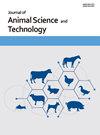有机溶剂对汉宇牛耳垢皮质醇提取的影响
IF 3.2
3区 农林科学
Q1 AGRICULTURE, DAIRY & ANIMAL SCIENCE
引用次数: 0
摘要
人类和非人类动物的耳垢是一种半液态物质,含有应激激素皮质醇。从耳垢中提取皮质醇需要使用有机溶剂来消除干扰因素。本试验旨在研究有机溶剂对汉宇牛耳垢皮质醇提取效率的影响。采用因子排列法确定溶剂源(甲醇,MA)的影响;二乙醚(DE)和测定稀释缓冲液(ADB)(0和1 mL)对3胎、体重= 462±5.6 kg的韩宇牛耳垢皮质醇浓度(ECC)的影响。将25mg部分耳垢样品悬浮在ADB中,而另25mg部分在用MA和DE提取之前未悬浮。使用商用酶联免疫吸附测定皮质醇试剂盒测量ECC。结果表明,加ADB或不加ADB均可从耳垢中提取皮质醇。MA对耳垢中皮质醇的提取率高于DE (<italic>p</italic>, lt;0.05)。综上所述,MA提取率高,提取工艺简单,溶剂消耗相对较低,是提取皮质醇的首选溶剂。此外,耳垢可以作为一种生物标志物来评估韩宇牛的慢性应激程度。本文章由计算机程序翻译,如有差异,请以英文原文为准。
Effect of organic solvents on earwax cortisol extraction in Hanwoo cattle
Earwax, a semi-liquid substance, of both humans and non-human animals contains the stress hormone cortisol. Extraction of cortisol from earwax requires the use of organic solvents to eliminate interference factors. This study aimed to investigate the effects of organic solvents on the extraction efficiency of earwax cortisol from Hanwoo cattle. A factorial arrangement was used to determine the effects of solvent source (methyl alcohol, MA; diethyl ether, DE) and assay diluent buffer (ADB) (0 and 1 mL) on earwax cortisol concentration (ECC) in Hanwoo cattle (parity 3, body weight = 462 ± 5.6 kg). A 25 mg portion of the earwax sample was suspended in ADB, while another 25 mg portion was not suspended prior to extraction with MA and DE. ECC was measured using a commercial enzyme-linked immunosorbent assay cortisol kit. The results indicated that cortisol can be extracted from earwax with or without ADB. The extraction yield of cortisol from earwax was higher with MA than with DE (p < 0.05). In conclusion, MA is the preferred solvent for cortisol extraction owing to its high extraction yield, simple extraction process, and relatively low solvent consumption. Moreover, earwax can be used as a biomarker to evaluate the degree of chronic stress in Hanwoo cattle.
求助全文
通过发布文献求助,成功后即可免费获取论文全文。
去求助
来源期刊

Journal of Animal Science and Technology
Agricultural and Biological Sciences-Food Science
CiteScore
4.50
自引率
8.70%
发文量
96
审稿时长
7 weeks
期刊介绍:
Journal of Animal Science and Technology (J. Anim. Sci. Technol. or JAST) is a peer-reviewed, open access journal publishing original research, review articles and notes in all fields of animal science.
Topics covered by the journal include: genetics and breeding, physiology, nutrition of monogastric animals, nutrition of ruminants, animal products (milk, meat, eggs and their by-products) and their processing, grasslands and roughages, livestock environment, animal biotechnology, animal behavior and welfare.
Articles generally report research involving beef cattle, dairy cattle, pigs, companion animals, goats, horses, and sheep. However, studies involving other farm animals, aquatic and wildlife species, and laboratory animal species that address fundamental questions related to livestock and companion animal biology will also be considered for publication.
The Journal of Animal Science and Technology (J. Anim. Technol. or JAST) has been the official journal of The Korean Society of Animal Science and Technology (KSAST) since 2000, formerly known as The Korean Journal of Animal Sciences (launched in 1956).
 求助内容:
求助内容: 应助结果提醒方式:
应助结果提醒方式:


